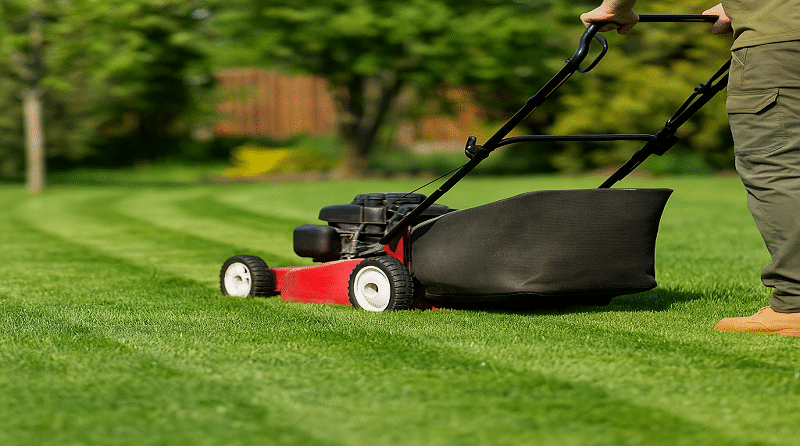As winter fades and temperatures rise, homeowners begin preparing their yards for the warmer months ahead. One of the most important spring lawn care tasks? Mowing your lawn at the right time and frequency. Cutting too early or too often can damage grass, while neglecting it can lead to overgrowth and disease. In this guide, we’ll break down when to start mowing in spring, how often to mow, and expert tips to keep your lawn healthy and green all season long.
When to Start Mowing Your Lawn in Spring
Timing is everything. Starting too soon can harm tender grass blades, while waiting too long can cause stress on the lawn and make mowing more difficult.
Signs It’s Time to Start Mowing:
- Grass height is 2.5 to 3 inches
- Soil is no longer soggy or frozen
- Consistent daytime temps are above 50°F (10°C)
- Grass is actively growing and green
Pro Tip: Avoid mowing when the soil is still soft—heavy mowers can cause ruts and soil compaction, which can stunt grass growth later in the season.
How Often Should You Mow in Spring?
The frequency of mowing depends on grass type, growth rate, and local weather. But as a general rule:
Spring Mowing Frequency:
- Cool-season grasses (like Kentucky bluegrass or fescue): Once every 5–7 days
- Warm-season grasses (like Bermuda or Zoysia): Once weekly as temps rise
Golden Rule:
Never cut more than 1/3 of the grass blade at a time. Cutting too short (a practice called scalping) can shock the grass, weaken roots, and invite weeds.
Best Practices for Spring Lawn Mowing
To ensure a lush, healthy lawn, follow these mowing best practices:
1. Sharpen Your Mower Blades
Dull blades tear grass instead of cutting it cleanly. This results in brown, frayed tips and can lead to disease. Sharpen blades at the start of the season and check periodically.
2. Adjust the Mower Height
Set your mower to the highest recommended setting for your grass type early in the season. Taller grass develops deeper roots and is more drought-tolerant.
3. Don’t Bag the Clippings
Grass clippings break down quickly and return nitrogen to the soil. This process, known as grasscycling, saves time and boosts lawn health naturally.
4. Change Mowing Patterns
Vary your mowing direction each time to prevent soil compaction and turf wear. This also encourages upright growth and a more even appearance.
If your lawn is still recovering from winter, consider scheduling a property cleanup to clear debris and prepare the grass for healthy growth.
5. Keep Mower Maintenance in Check
Besides blade sharpening, clean under the mower deck to prevent buildup and check for fuel, oil, and spark plug needs before each use.
Common Spring Mowing Mistakes to Avoid
- Starting too early when the lawn hasn’t dried out
- Mowing wet grass, which causes clumping and uneven cuts
- Scalping (cutting too low), which weakens turf and promotes weeds
- Skipping early mowing, causing tall grass that’s difficult to manage
Extra Spring Lawn Care Tips
Mowing is just one part of a complete spring lawn care strategy. For the best results, consider the following:
1.Fertilize After the First Few Mows
Once your lawn is actively growing, apply a balanced spring fertilizer to support lush growth. Choose a slow-release formula to nourish over time.
2.Overseed Bare Spots
Spring is ideal for overseeding patchy areas, especially after mowing or aeration. This helps promote thick, even grass coverage.
3.Aerate Compacted Soil
Heavy winter snow or foot traffic can compact soil. Spring aeration helps water, air, and nutrients reach the roots. Explore core aeration services for optimal results.
4.Dethatch If Needed
A thick thatch layer can block nutrients and water. Dethatching in spring helps break up that layer and promotes better root growth.
5.Consider Professional Spring Cleanup
If your lawn still shows signs of winter debris, dead leaves, or damage, a professional spring property cleanup can prepare it for the season ahead.
Conclusion: Mow Smart for a Healthy Spring Lawn
A great lawn starts with smart mowing habits. Begin when the grass is ready, mow consistently without overdoing it, and use sharp blades to promote clean cuts. With these tips, your lawn will thrive throughout spring and into summer.
FAQs
Q1: When should I start mowing my lawn in spring?
Start mowing when the grass reaches 2.5 to 3 inches tall and the soil is dry—not soggy or frozen.
Q2: How often should I mow my lawn during spring?
Cool-season grasses typically need mowing every 5–7 days, while warm-season grasses may need weekly mowing as temperatures rise.
Q3: Is it okay to mow wet grass in spring?
Avoid mowing wet grass as it leads to uneven cuts, clumping, and potential damage to your lawn and mower.
Q4: What’s the ideal cutting height in spring?
Keep your mower set to the highest recommended setting and never remove more than 1/3 of the blade in a single cut.
Q5: Should I aerate my lawn in spring?
Yes, spring is a great time to aerate your lawn to reduce compaction and promote healthy root growth. Check out our core aeration service for details.


